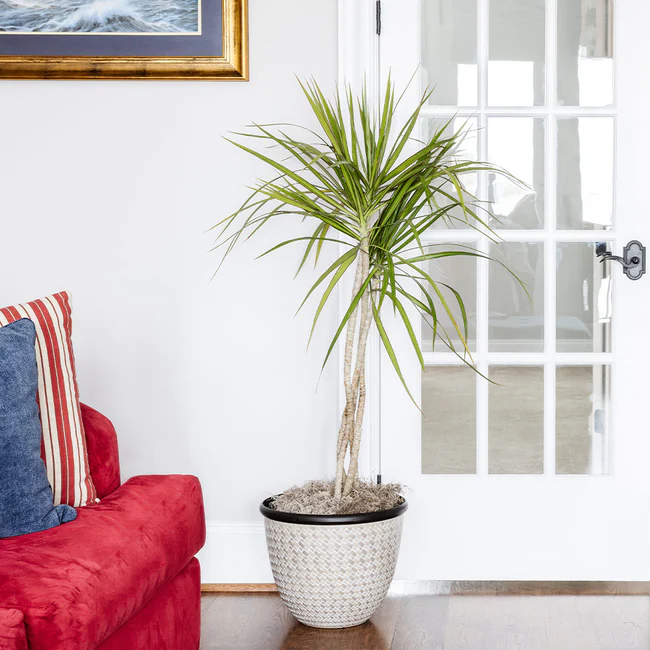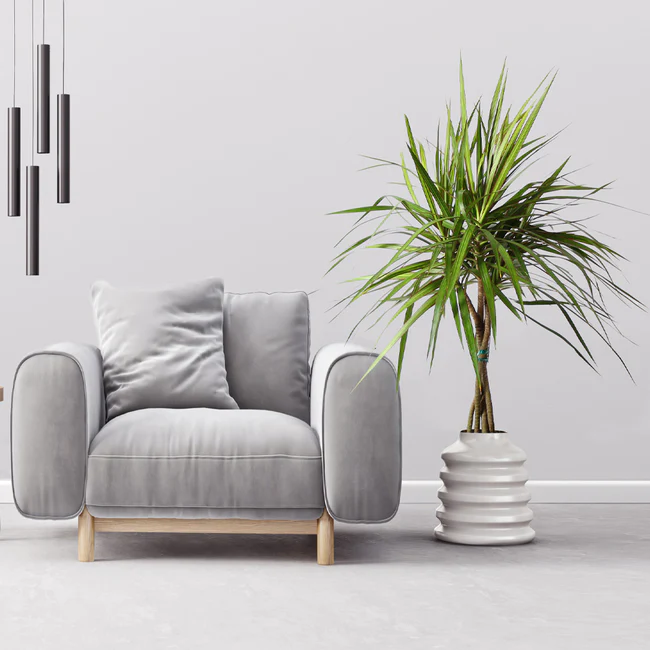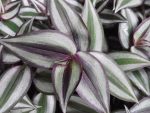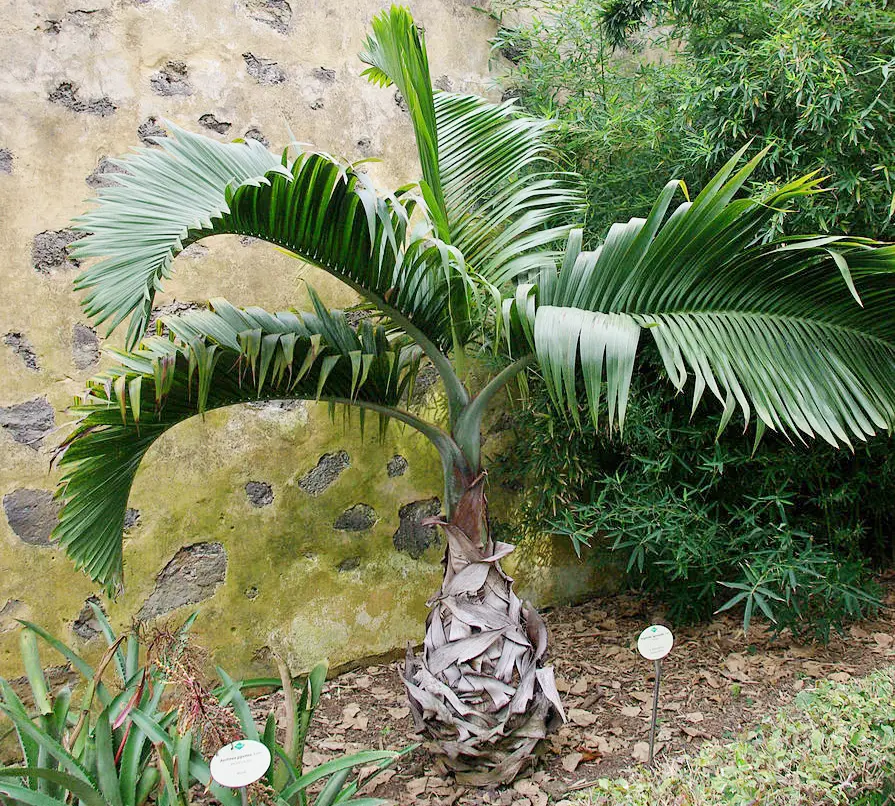This post contains affiliate links. If you buy something from one of our links we may earn a commission. Thanks
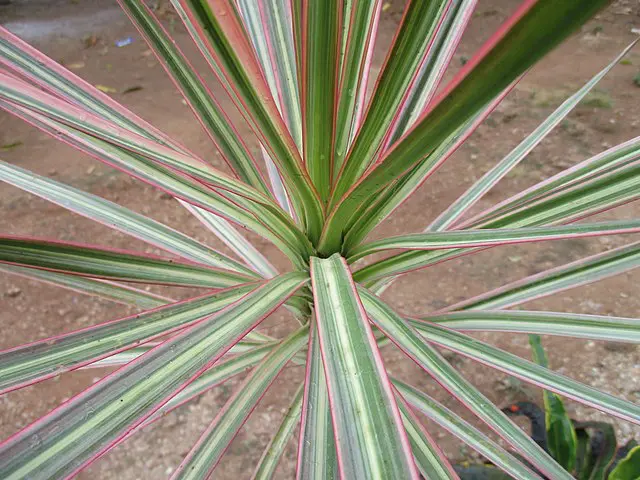
If you’re looking to add a touch of greenery to your home, the Dracaena Marginata, also known as the Dragon Tree or the Madagascar Dragon Tree is an excellent choice.
Dracaena Marginata, also known as the Dragon Tree, is a low-maintenance indoor plant that brings a touch of the wild to your home. With its slender trunk topped by a shock of slender leaves, it’s a striking addition to any room.
Although it doesn’t demand much attention, understanding its basic needs is key to enjoying this unique plant for many years. Its care involves a balance of the right light, water, and regular check-ups for potential issues like pests or diseases.
Not only are these dracaena plants aesthetically pleasing with their long, slender leaves that can grow up to several feet tall, but it is also low maintenance and easy to care for.
However, to ensure that your Dragon Tree plant thrives indoors, it’s important to follow proper care techniques.
In this article, we’ll cover the essential Dracaena Marginata Care Indoors and Dragon Tree Care Tips to help you keep your plant healthy and vibrant.
Whether you’re a seasoned plant grower or a newcomer to indoor gardening, these tips will guide you in providing the best care for your Dracaena Marginata.
Generally, D. marginata is a slow grower, so it may be worth starting with a larger plant so you can start enjoying it sooner.
You can buy a Dacaena Dragon Tree here at Fast Growing Trees
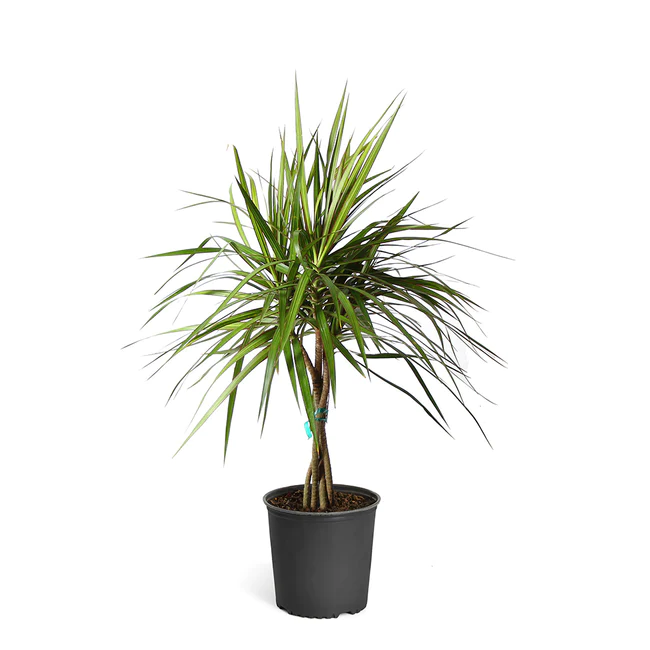
What Is Dracaena Marginata?
Dracaena Marginata is a species of flowering plant in the Asparagaceae family, native to Madagascar.
It is a slow-growing, evergreen tree with long, narrow leaves that are often green and red with a distinct red edge.
Another popular plant in the Dracaena genus is the Corn Plant (dracaena fragrans).
It is better to buy a plant labeled with its scientific name because the common name is often wrong or has multiple uses and could be used for a totally different plant.
The Madagascar Dragon Tree can grow up to 15 feet tall in its natural habitat, but it is commonly grown as a houseplant, reaching a height of 6-10 feet.
Benefits Of Having Dracaena Plants In Your Home
Not only does the Dracaena Marginata add a touch of tropical charm to any room, but it also has numerous benefits for your home.
Firstly, it is an excellent air purifier, removing toxins such as formaldehyde and benzene from the air.
Additionally, it helps to increase humidity levels, making it an ideal plant for dry indoor environments.
It is also known to improve indoor air quality by releasing oxygen and decreasing carbon dioxide levels.
Lastly, the Dracaena Marginata is a low-maintenance plant that can survive with minimal care, making it a great choice for those who are new to indoor gardening.
The Importance Of Proper Dracaena Marginata Care:
To ensure that your Dracaena Marginata stays healthy and continues to thrive, it is important to provide proper care.
This includes providing the right amount of sunlight, watering the plant properly, and maintaining a comfortable temperature and humidity level.
Additionally, regular pruning and repotting are also important to promote healthy growth and prevent the plant from becoming root-bound.
By following these care tips, you can help your Dracaena Marginata to grow strong and healthy, providing you with a beautiful and lush indoor tropical plant for many years to come.
Dracaena Marginata Care Indoors
Proper care is crucial for the health and longevity of your Dracaena Marginata. In this section, we’ll go over several key aspects of Dragon Plant Care, including the importance of selecting the right location, maintaining proper temperature and humidity levels, and choosing the right soil for your plant.
By following these care tips, you can help ensure that your Dracaena Marginata stays healthy and continues to thrive.
Tip 1. Choose The Right Location For Your Dragon Plant:
The location where you place your Dracaena Marginata is critical to its health and growth. It is important to choose a spot that provides the right amount of light, warmth, and humidity.
The plant prefers bright indirect light, but it can also tolerate low light conditions.
However, direct sunlight can cause the leaves to scorch, so it’s best to avoid placing them near windows that receive direct sunlight.
Tip 2. Proper Temperature And Humidity Levels:
The ideal temperature range for Dracaena Marginata is between 65-75°F, with a minimum temperature of 50°F.
The plant is also sensitive to sudden changes in temperature and humidity, so it’s important to maintain stable conditions.
In terms of humidity, the plant prefers a moist environment of 60% to 80%humidity.
But it can tolerate low humidity levels as well. To increase humidity levels, you can place a humidifier nearby or place a tray of water near the plant.
You can also place your pot on top of a pebble tray and mist it once or twice a week to raise humidity.
Tip 3. Dracaena Soil Requirements:
The soil for your Dracaena Marginata should be well-draining and have a neutral pH of 6.0-7.0.
A good quality, commercial potting mix is a great choice for this plant, or you can make your own mix using equal parts of coco coir and perlite.
Additionally, it’s important to ensure that the pot has adequate drainage holes to prevent water from accumulating in the bottom and causing root rot.
By providing the right soil conditions, you can help ensure that your Dracaena Marginata has the necessary nutrients to grow strong and healthy.
Tip 4. Dracaena Marginata Light Requirements:
One of the key factors in successfully caring for your Dracaena Marginata is providing it with the right amount of sunlight.
This tropical plant originates from East Africa and prefers bright indirect light in its natural habitat.
In your home, it’s important to strike a balance between providing enough light for your plant to thrive, while also protecting it from intense, direct sunlight that can cause sunburn and other damage.
In this section, we’ll take a closer look at the ideal light conditions for your Dracaena Marginata and provide tips for keeping your plant healthy and happy.
How much sunlight do Dracaena plants need?
The Dracaena Marginata is a low-light plant, but it still benefits from bright, indirect light.
Place your plant near a window that gets bright, filtered light but not too much direct sun.
Direct sunlight can cause sunburn and damage to the leaves, while too little light can result in slow growth and yellowing leaves.
Signs of too much or too little sunlight
If your Dracaena Marginata is getting too much sun, you may notice the leaves becoming discolored or even sunburned.
Conversely, if your plant isn’t getting enough light, its leaves may become pale and limp, and growth may slow.
Tips for providing the right amount of sunlight
To provide the right amount of light for your Dracaena Marginata, place it near a window that gets bright, indirect light.
You can use sheer curtains or a sheer shade to filter the sun and protect your plant from direct sunlight.
If your plant is still not getting enough light, you can supplement it with artificial light, such as a fluorescent light or LED grow light placed above the plant.
Remember, the right amount of light will vary depending on the time of year, the climate, and the location of your home.
Keep an eye on your plant and adjust its location as needed to ensure that it is getting the right amount of light.
Tip 5. Dracaena Marginata Watering:
Proper watering is essential to the health and growth of your Dracaena Marginata plant. Overwatering or underwatering can lead to problems such as root rot or wilting.
In this section, we’ll discuss the best watering practices for Dracaena Marginata and how to avoid common mistakes.
Understanding how to water your Dracaena Marginata is an important step in keeping it healthy and thriving.
How Often to Water:
Dracaena Marginata plants prefer to be kept evenly moist but not waterlogged. During the growing season, the plant should be watered once a week, or when the top inch of soil is dry.
In the winter months, the plant can be watered less frequently, about once every 2-3 weeks, or when the top inch of soil is dry.
Signs of Over or Under Watering:
Overwatering: Overwatering is a common problem for Dracaena Marginata plants. Symptoms of overwatering include yellowing of the leaves, stunted growth, and a mushy texture to the stem near the soil line.
Underwatering: Underwatering can also be a problem for Dracaena Marginata plants. Symptoms of underwatering include drooping leaves, brown tips on the leaves, and slow growth.
Watering Techniques:
Bottom Watering: Bottom watering involves placing the plant in a tray filled with water and allowing the soil to soak up the moisture. This method is helpful for avoiding overwatering and helps ensure that the soil remains evenly moist.
Top Watering: Top watering involves watering the soil from above and is the most common way plants are watered. But it’s not always the best.
Misting: Misting the leaves of the Dracaena Marginata with water can help increase humidity and prevent the plant from becoming too dry.
This is especially important during the winter months when indoor air can be very dry.
In conclusion, proper watering is key to the health and growth of your Dracaena Marginata plant. By following these tips and monitoring for signs of over or under-watering, you can ensure that your plant receives the moisture it needs to thrive.
Bottom Vs Top Watering
Bottom watering and top watering are two different methods of watering plants, each with its own advantages and disadvantages.
Bottom watering involves placing the plant pot in a tray filled with water and allowing the soil to absorb the moisture from the bottom up.
This method is especially useful for preventing overwatering and ensuring that the soil remains evenly moist.
It also helps prevent water from sitting on the leaves, which can lead to leaf rot.
Top watering involves watering the soil directly from the top. This method is more common and can be easier to manage, as you can see when the soil is dry and needs water.
However, it’s important to avoid getting water on the leaves, as this can lead to leaf rot.
Additionally, top watering can result in inconsistent moisture levels, as the water may not be absorbed evenly throughout the soil.
Ultimately, the best method of watering depends on the specific needs of your plant and the environment in which it’s grown.
Experiment with both top and bottom watering to see which works best for your Dragon Plant, and adjust as needed based on the plant’s response.
Tap Water Vs Distilled Water
Tap water can contain chloramines or fluorides or other minerals that can build up in excess in the soil and affect your plant’s health.
The symptoms may include browning of leaf edges, and leaf tips, and chlorosis (yellow leaves).
So use distilled or RO water or install a filter on your tap. Using rainwater is also a good idea for watering.
Tip 6. Dracaena Marginata Pruning
Pruning is an important aspect of Dracaena Marginata care, as it helps promote healthy growth and maintain the plant’s shape.
Whether you’re looking to encourage new growth or simply remove yellow or damaged leaves, pruning is a simple and effective way to keep your Dragon Tree looking its best.
In this section, we’ll cover the basics of Dracaena Marginata pruning, including when to prune, how to prune, and tips for successful pruning.
Why pruning is important
Pruning is important for Dracaena Marginata for several reasons. Firstly, it helps to keep the plant healthy by removing yellow, dead, or diseased leaves.
This promotes healthy new growth and ensures that the plant’s energy is being directed toward its most vital parts.
Pruning also helps to maintain the plant’s shape and size, allowing you to control its overall appearance.
How often to prune
Dracaena Marginata should be pruned regularly, as needed, to remove yellow or damaged leaves.
However, it’s important not to prune too often, as this can result in stunted growth and a lack of energy for the plant.
A good rule of thumb is to prune once or twice a year, or as needed, to maintain the plant’s health and appearance.
Step-by-step guide to pruning your Dracaena Marginata
Choose the right tools: Use a sharp, clean pair of shears to prune your Dracaena Marginata.
Identify the leaves to be pruned: Look for yellow, dead, or damaged leaves, as well as any leaves that are crossing or rubbing against each other.
Cut the leaves: Using your shears or scissors, make a clean cut just above a leaf node.
Repeat: Repeat the process until all of the desired leaves have been pruned.
Dispose of the cuttings: Dispose of the cuttings in the trash or compost pile.
It’s important to follow these steps carefully to ensure that your Madagascar Dragon Tree is pruned correctly and to avoid damaging the plant.
Heading Back Stems To Reduce Height And Make It Bushier
In addition to removing yellow or damaged leaves, pruning can also be used to reduce the height of your Dracaena and promote bushier growth. This is accomplished by cutting back the main stem of the plant.
To reduce the height of a Dracaena Marginata and encourage bushier growth:
Choose a stem: Look for the tallest stem of the plant that you would like to reduce.
Make the cut: Using a clean, sharp pair of shears or scissors, make a cut just above a leaf node.
Wait for new growth: After making the cut, wait for new leaves will begin to emerge from the leaf node. This new growth will form new stems, which will eventually create a bushier plant.
It’s important to note that cutting back the main stem of a Dracaena Marginata can be a significant change for the plant, and it may take some time for new growth to emerge.
However, with patience and proper care, your Dracaena Marginata will recover and grow back bushier and stronger than ever.
Tip 7. Dracaena Marginata Repotting
Repotting is an important part of Dracaena Marginata care, as it allows the plant to grow and develop properly.
Whether your Dracaena Marginata is growing too large for its current pot or simply needs fresh soil, repotting can provide the necessary space and nourishment for the plant to thrive.
In this section, we’ll cover the steps and tips for successfully repotting your Dracaena Marginata.
A. How often to repot
Dracaena Marginata is a slow-growing plant but eventually, it will need to go into a larger pot.
Repotting your Dracaena Marginata is usually required once every 2-3 years.
However, the frequency of repotting can vary based on factors such as the size of the plant, the growth rate, and the size of the pot.
To determine if your Dracaena Marginata needs repotting, check if the roots are growing out of the drainage holes or if the plant has outgrown its pot.
B. Step-by-step guide to repotting your Dracaena Marginata
Here are the steps for repotting your Dracaena Marginata:
Prepare the new pot: Choose a pot that is 2-3 inches larger in diameter than the current pot. Fill the bottom of the pot with a well-draining potting mix.
Remove the plant from the old pot: Gently loosen the roots from the old pot by grasping the stem near the base of the plant and gently tugging. If the roots are tightly packed, use a knife or pruning shears to carefully cut through the root ball.
Prune the roots: Remove any dead or damaged roots and trim back the root ball by about 1/3.
Place the plant in the new pot: Place the plant in the new pot and add potting mix around the root ball, firming it gently to remove any air pockets.
Water: Water the plant thoroughly to help settle the potting mix and encourage root growth.
C. Tips for successful repotting
• Use a well-draining potting mix specifically formulated for houseplants for best results.
• Choose a pot with drainage holes to prevent excess water from standing in the soil and causing root rot.
• Avoid over-potting, as the plant may become pot-bound and struggle to establish itself in the new pot.
• Give the plant a few days to adjust to its new pot before returning to normal watering and care routines.
By following these steps and tips, you can ensure that your Dracaena Marginata is repotted successfully and has the space and resources it needs to grow and thrive.
Dracaena Marginata Propagation:
Propagating your Dracaena Marginata is a great way to create new plants for your home or to share with friends and family.
There are several methods for propagating this plant, including stem cuttings, division, and air layering.
This section will explore these methods in detail, including the necessary materials, steps, and tips for successful propagation.
Whether you’re looking to create new plants or simply to expand your collection, Dracaena Marginata propagation is a fun and rewarding project for indoor gardeners.
Propagation Techniques:
There are two main methods of Dracaena Marginata propagation: stem cuttings and division.
Cuttings:
Stem cuttings are a popular and straightforward method of propagating your D. Marginata.
Simply take a cutting from a healthy stem and plant it in a pot filled with a well-draining soil mixture.
With proper care, the cutting will root and develop into a new plant.
Division: Division is another method of propagating your Dracaena Marginata.
This method involves separating the plant into smaller sections, each with its own root system, and planting them in separate pots.
This propagation method is ideal for older plants that have become too large for their current pot and need repotting anyway.
B. Step-by-Step Guide to Propagating Your Dracaena Marginata:
Cuttings:
Cut a stem section about 6-8 inches long, making sure it has at least two leaves and a node (a small bump on the stem where leaves grow).
Remove the lower leaves and let the cutting sit for a day or two to allow the cut end to callus over.
Fill a pot with a well-draining soil mixture.
Dip the cut end of the stem in rooting hormone, if desired.
Insert the stem into the soil, making sure that the node is below the soil surface.
Water the soil thoroughly and place the pot in a warm, bright location.
Keep the soil moist and mist the leaves occasionally to increase humidity levels.
After several weeks, you should see new growth, which indicates that the cutting has rooted and is ready to be potted up.
Division:
Water the plant well and remove it from its pot.
Gently separate the plant into smaller sections, each with its own root system.
Repot each section in its own pot, filled with well-draining soil mixture.
Water the soil thoroughly and place the pots in a warm, bright location.
Keep the soil moist and mist the leaves occasionally to increase humidity levels.
C. Tips for Successful Propagation:
Choose healthy, vigorous stems or plants for propagation.
Make sure to use a well-draining soil mixture.
Keep the soil moist but not waterlogged.
Place the pots in a warm, bright location but away from direct sunlight.
Mist the leaves regularly to increase humidity levels.
Be patient, as it can take several weeks to several months for the new plants to root and grow.
IV. Dracaena Marginata Outdoors:
While the Madagascar Dragon Tree is primarily grown as an indoor plant, it can also be grown outdoors in warm, frost-free climates.
These attractive and low-maintenance tropical plants plant adds a touch of greenery to any outdoor space and is ideal for patios, balconies, or courtyards.
In this section, we’ll discuss the key factors to consider when growing Dracaena Marginata outdoors, including location, soil, and water requirements, as well as tips for protecting the plant from harsh weather conditions.
A. Can Dracaena Marginata be Grown Outdoors?
Dracaena Marginata can be grown outdoors in warm, frost-free climates. It is native to Madagascar, where it grows in tropical forests, so it prefers warm and humid conditions. In areas with cooler climates or frost, it is best to grow the plant indoors.
B. Ideal Conditions for Outdoor Growth:
USDA hardiness zones: Dracaena Marginata can be grown outdoors in USDA hardiness zones 10 and 11, where temperatures do not fall below 30°F (-1°C) and can safely tolerate temperatures as low as 40°F.
Location: Choose a location that is protected from strong winds and direct sunlight. The plant prefers bright, indirect light, but it can tolerate some shade.
Soil: The plant prefers well-draining soil that is rich in organic matter.
Water: Water the plant regularly, making sure the soil remains moist but not waterlogged.
Temperature: Dracaena Marginata prefers warm temperatures, between 60°F and 80°F (15°C – 26°C). It can tolerate some frost, but it is best to protect the plant from temperatures below 30°F (-1°C).
C. Care Tips for Outdoor Dracaena Marginata:
Water the plant regularly, making sure the soil remains moist but not waterlogged.
Fertilize the plant with a balanced fertilizer every 3-4 months during the growing season.
Prune the plant regularly to keep its shape and size under control.
Protect the plant from strong winds and extreme temperatures.
Bring the plant indoors or provide protection (such as a frost blanket or move it to a sheltered location.
Dragon Plant Problems
As much as we all love having a beautiful Dracaena Marginata in our homes, it’s important to be aware of potential problems that may arise.
In this section, we will cover some of the most common insect pests, diseases, and treatments for your Dragon Tree.
A. Insect Pests
Spider Mites: Small, eight-legged pests that spin webs on the undersides of leaves.
Mealybugs: Tiny insects that secrete a sticky, white substance on the plant’s leaves and stems.
Scale Insects: Immobile insects that attach themselves to the stems and leaves of the plant.
Treatment: To control insect pests, it’s important to identify the specific pest and choose an appropriate treatment. For example, insecticidal soap or neem oil can be used to control spider mites and mealy bugs, while a mixture of rubbing alcohol and water can be used to control scale insects.
B. Diseases
Root Rot: A fungal disease that occurs when the roots are left in water for too long.
Leaf Spot: A fungal disease that results in brown spots on the leaves.
Yellowing Leaves: A common issue that can be caused by a variety of factors, including over-watering, under-watering, and lack of sunlight.
Treatment: To prevent and treat diseases, it’s important to provide the plant with proper care, including the right amount of water, sunlight, and nutrients. If a disease does occur, removing infected leaves and improving the overall care of the plant can often help to recover. In severe cases, fungicides may be necessary.
In conclusion, with proper care and attention, your Dracaena Marginata can thrive and avoid these common insect pests and diseases. Keep an eye out for any signs of trouble and don’t hesitate to seek professional advice if needed.
Dracaena Marginata FAQs
Let’s delve into some frequently asked questions to better understand how to care for your Dracaena Marginata:
Q. How big will my Dracaena Marginata plant grow?
A. The growth of your Dracaena Marginata largely depends on the conditions it’s placed in. In optimal indoor conditions, it can grow up to 6 feet tall. However, in warm outdoor climates, it has the potential to reach a height of up to 20 feet.
Q. Is Dracaena Marginata toxic to cats?
A. Yes, unfortunately, Dracaena Marginata can be highly toxic to cats. It’s advisable to keep this plant out of reach if you have curious feline friends at home.
Q. How do you care for Dracaena Marginata?
A. Dracaena Marginata is relatively easy to care for. It thrives in a variety of light conditions but prefers indirect bright light.
It’s essential to avoid over-watering this plant; ensure the top half of the soil is dry before watering.
Additionally, rotating the pot by a ¼ turn once a month and occasionally dusting the leaves are good practices to keep your Dragon Tree healthy.
Q. Is Dracaena Marginata an indoor or outdoor plant?
A. While Dracaena Marginata can grow outdoors in warm climates, it’s generally grown as a potted houseplant.
Its ability to thrive in indoor conditions makes it a popular choice for bringing a touch of greenery indoors.
Q. Does Dracaena Marginata need much light?
A. Dracaena Marginata grows best in bright light but can also adapt to partial shade.
However, in lower light conditions, it tends to grow slower and produce smaller leaves with less vibrant colors.

Conclusion
In conclusion, the Dracaena Marginata, also known as the Dragon Tree, is a beautiful and low-maintenance indoor plant that can bring a touch of nature to your home.
Proper care, including the right amount of water, light, and humidity, will help your plant thrive and grow.
By following the tips outlined in this article, you can ensure that your Dracaena Marginata stays healthy and beautiful for years to come.
Whether you’re a seasoned grower or just starting out, with a little attention and care, your Dracaena Marginata will become a valued addition to your indoor garden.
In this article, we covered the 10 essential care tips for keeping your Dracaena Marginata healthy and thriving indoors.
These tips included: location selection, temperature and humidity levels, soil requirements, watering techniques, pruning, repotting, lighting requirements, propagation techniques, growing outdoors, and dragon tree problems.
If you follow these tips it will help ensure that your Dracaena Marginata stays healthy and grows beautifully. Remember, every plant is unique, so it may take some trial and error to figure out the best care routine for your Dragon Tree.
We encourage you to share your experiences and knowledge of Dracaena Marginata care with others.
Whether you have tips of your own or simply want to show off your beautiful plant, sharing your experiences with others can help to build a community of plant enthusiasts and spread the love for these wonderful indoor plants.
So take care of your Dracaena Marginata and happy planting!
You can get your Dracaena Marginata here
Read about the 20 Benefits Of Keeping Indoor Plants For Improved Lifestyle

